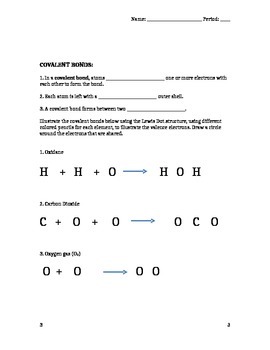38 overview chemical bonds worksheet answers
12 Nov 2013 — Read this passage from the text and answer the questions that follow. Chemical Bonding. Elements form compounds when they combine chemically ...
Key Points · Chemical bonds are forces that hold atoms together to make compounds or molecules. · Chemical bonds include covalent, polar covalent, and ionic bonds ...
The hydrogen bonds in the silk form beta pleated sheets rather than alpha helixes because of where the bonds occur. The hydrogen bonds go from the amide hydrogens on one protein chain to the corresponding carbonyl oxygen across the way on the other protein chain. This is in contrast to the alpha helix because in that structure the bonds go from the amide to the …

Overview chemical bonds worksheet answers
Click the buttons to print each worksheet and associated answer key. Blood Types . The frequencies of blood types vary in populations around the world. For example, the frequencies of the A, B, AB, and O blood types differ in three US populations as shown below. The Human Skeleton. Label the following parts of the human Skeletal system on the diagram. Anatomy of …
Chemical bonds hold molecules together and create temporary connections that are essential to life. Types of chemical bonds including covalent, ionic, and hydrogen bonds and London dispersion forces. If you're seeing this message, it means we're having trouble loading external resources on our website. If you're behind a web filter, please make sure that the domains …
28/06/2021 · Acrylic acid has the chemical formula of CH 2 CHCOOH. So, it is a 3-carbon compound starting with a carboxylic acid and between carbons 2 and 3 is a double bond:
Overview chemical bonds worksheet answers.
15 Aug 2020 — Chemical bonding is one of the most basic fundamentals of chemistry that explains other concepts such as molecules and reactions.
Start studying Overview: Chemical Bonds. Learn vocabulary, terms, and more with flashcards, games, and other study tools. Rating: 5 · 5 reviews
23 Jan 2017 — A chemical bond is an attraction between two or more atoms, and is what forms a chemical. This is an electrostatic attraction - an attraction ...
About This Quiz & Worksheet. Most of the questions will present you with an image of one or two molecules. You will need to identify the different properties of the given molecules.
Chemical Bonding. Name KEY ... Why do most atom form chemical bonds? Atoms form chemical bonds to minimize their potential energy
Covalent Bonds. Another type of strong chemical bond between two or more atoms is a covalent bond. These bonds form when an electron is shared between two elements and are the strongest and most common form of chemical bond in living organisms. Covalent bonds form between the elements that make up the biological molecules in our cells. Unlike ...
Content Outline Chemical Bonds for Teaching. Section 1 Why do atoms combine? Underlined words and phrases are to be tilled.12 pages
The forces that hold matter together are called chemical bonds. ... The ionic bond is formed by the attraction between oppositely charged ions.11 pages
RENEWABLE ENERGY OVERVIEW a. POLICY BENEFITS OF RENEWABLE ENERGY FACILITIES b. COST-EFFECTIVENESS OF RENEWABLE ENERGY. What are “Renewable Resources”? The term “renewable” is generally applied to those energy resources and technologies whose common characteristic is that they are non-depletable or naturally …
Chemistry Scavenger Hunt (pdf)-Internet lesson using the sites listed on the Chemistry page of the Kid Zone. Periodic Tables Online (pdf) - A worksheet I use to review the basics of the periodic table. The sites for this worksheet are listed on the Chemistry links page of the Kid Zone.NOTE: This is the optional page 2 mentioned in the BrainPOP Periodic Table link below.
bonds between atoms in the molecule. (PP 7) Because of the weak nature of most non-covalent bonds and because of interactions between the biomolecule and the solvent, the biomolecule’s structure is flexible rather than static. C. Stereochemistry As is common with organic compounds, many biomolecules exhibit stereochemistry. When four ...
in the chemical bonds of carbohydrate molecules. The principal carbohydrate formed through photosynthesis is glucose. Other types of organisms, such as animals, fungi, protozoa, and a large portion of the bacteria, are unable to perform this process. Therefore, these organisms must rely on the carbohydrates formed in plants to obtain the energy necessary for their metabolic …

0 Response to "38 overview chemical bonds worksheet answers"
Post a Comment